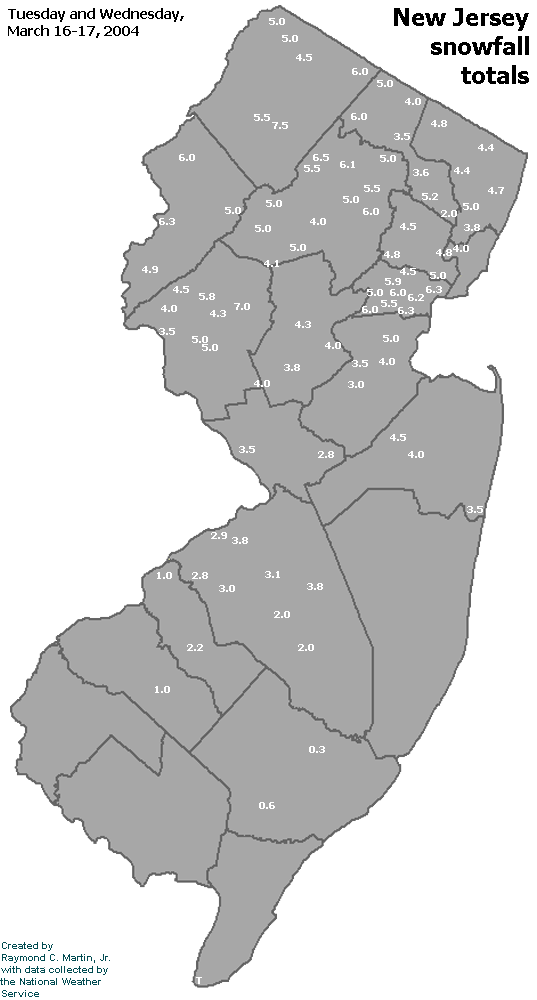

Storm description, surface observations, snowfall totals, and images courtesy of the National Climatic Data Center, the National Centers of Environmental Prediction, the Climate Prediction Center, the Hydrometeorological Prediction Center, the Mount Holly National Weather Service Office, the Upton National Weather Service Office, Rutgers University, Plymouth State University, the University of Illinois, the American Meteorological Society, Weather Graphics Technologies, AccuWeather, and the Weather Channel.
Table of Contents
Storm Summary
Regional Surface Observations
National Weather Service Forecasts
Surface Maps
Satellite Imagery
National Surface Weather Maps - Pressure and Fronts Only
Continental Surface Weather Maps - Pressure and Fronts Only
Sea Level Pressure and 1000 to 500 Millibar Thickness Maps
850 Millibar Maps
700 Millibar Maps
500 Millibar Maps
300 Millibar Maps
200 Millibar Maps
National Radar Imagery
Regional Radar Imagery
Fort Dix Doppler Radar Imagery
Storm Photos

Contoured Snowfall Totals from March 16-17, 2004
STORM DESCRIPTION
A large and complex late winter storm system brought heavy snow to northwestern New Jersey and a mix of snow, sleet and freezing rain across northeastern, central, and southwestern New Jersey.
Synoptic Discussion
The low pressure system responsible for the snow moved from the central Plains on the morning of the 15th eastward to near Kansas City by the evening of the 15th. It continued eastward to the Tennessee Valley by the morning of the 16th and reached West Virginia by the early aftternoon of the 16th. Meanwhile, a secondary low pressure began to develop along the primary low's warm front near Norfolk, Virginia, and strengthened into the primary low pressure system by the evening of the 16th. It then moved quickly offshore, and was southeast of Nantucket, Massachusetts by the early morning of the 17th.
Local Discussion
Snow spread from south to north across the state during the morning of the 16th. Across Cumberland and Cape May counties, the snow quickly changed to rain, but further north the changeover was slow enough to allow the snow to accumulate. Warmer air continued moving northward, and the snow changed to rain across Salem, Gloucester, Camden, Atlantic, Burlington and Ocean counties during the late morning and early afternoon hours of the 16th. Further north, the cold air remained in place at the lower levels of the atmosphere, forcing the warmer air from the south to rise over the low level cold air. This caused the snow to change to sleet across Mercer, Monmouth, Middlesex Somerset, Union, Essex and Hudson counties during the mid afternoon of the 16th. Further north, precipitation remained in the form of snow due to persistent cold air at all levels of the atmosphere. A burst of very heavy precipitation moved through the state late in the afternoon of the 16th, causing colder air to briefly regain dominance. This resulted in the sleet across west-central and northeastern New Jersey and the rain in east-central and southwestern New Jersey to briefly turn back into a heavy burst of snow before precipitation began to taper off. During the evening, lingering light precipitation reverted to rain across much of the state as low level cold air finally receeded further north, but during the late evening and overnight hours, colder air returned aloft and precipitation changed back to snow before finally tapering off. The heaviest accumulations were in the northern parts of the state where precipitation remained in the form of snow. Snowfall totals ranged from 4 to 8 inches in Sussex County, 3 to 7 inches in Warren, Morris, Hunterdon, Somerset, Passaic, and Union counties, 3 to 6 inches in Bergen, Essex, Hudson, and Middlesex counties, 3 to 5 inches in Mercer and Monmouth counties, 2 to 4 inches in Burlington and Ocean counties, 1 to 3 inchs in Camden County, a coating to 2 inches in Gloucester County, a coating to an inch in Salem and Atlantic counties, and a coating or less in Cumberland and Cape May counties.
New Jersey Snowfall Totals

Individual Snowfall Totals from March 16-17, 2004
Regional Snowfall Totals

Snowfall Totals from 1700Z 17 March 2004 (12PM EST 17 March 2004)
Table of Contents
Storm Summary
Regional Surface Observations
National Weather Service Forecasts
Surface Maps
Satellite Imagery
National Surface Weather Maps - Pressure and Fronts Only
Continental Surface Weather Maps - Pressure and Fronts Only
Sea Level Pressure and 1000 to 500 Millibar Thickness Maps
850 Millibar Maps
700 Millibar Maps
500 Millibar Maps
300 Millibar Maps
200 Millibar Maps
National Radar Imagery
Regional Radar Imagery
Fort Dix Doppler Radar Imagery
Storm Photos
Snow and ice storm, December 5-6, 2003
Snow storm, December 14-15, 2003
Snow storm, January 14-15, 2004
Snow and ice storm, January 17-18, 2004
Snow storm, January 26, 2004
Snow and ice storm, January 27-28, 2004
Snow and ice storm, March 16-17, 2004
Snow storm, March 18-19, 2004
Back to Ray's Winter Storm Archive
Copyright © 2012 by Raymond C Martin Jr. All rights reserved